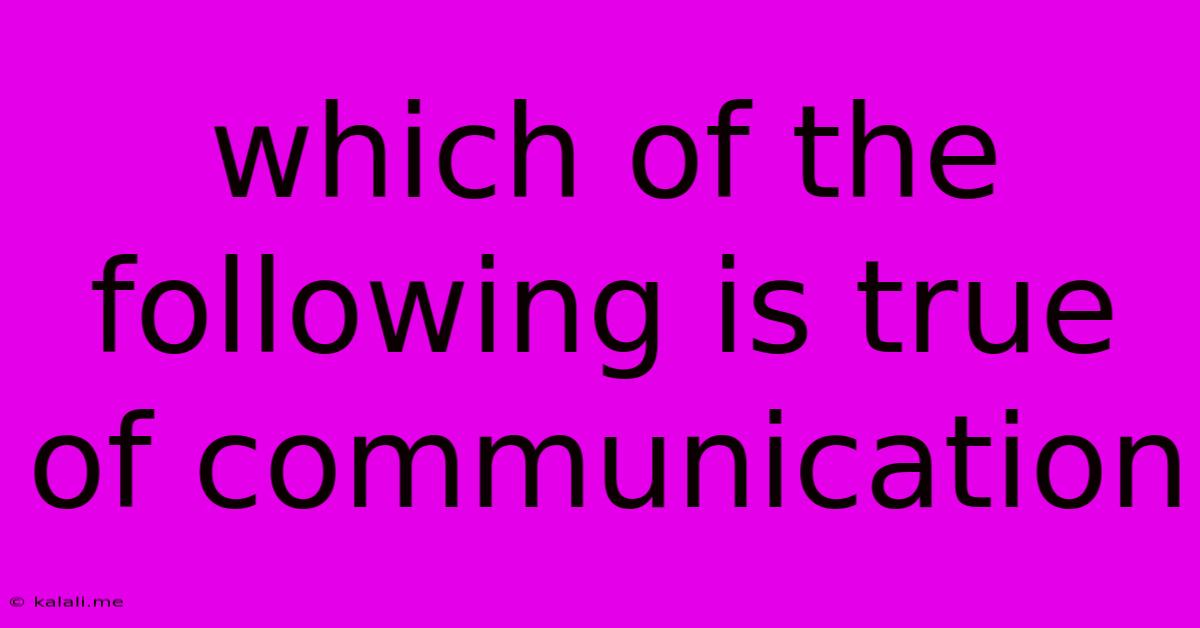Which Of The Following Is True Of Communication
Kalali
Jun 15, 2025 · 3 min read

Table of Contents
Which of the Following is True of Communication? A Deep Dive into Communication Principles
Communication is the cornerstone of human interaction, impacting everything from personal relationships to global politics. Understanding its intricacies is crucial, not just for effective interactions but also for navigating the complexities of life. This article explores the fundamental truths about communication, dispelling common misconceptions and clarifying key principles. We'll examine several potential statements about communication and determine their accuracy, offering insights into what truly makes communication effective.
Meta Description: Uncover the fundamental truths about communication! This article explores key principles, debunks common myths, and clarifies what makes communication truly effective. Learn how to improve your communication skills and navigate the complexities of human interaction.
Common Misconceptions about Communication
Before delving into specific statements, let's address some common misunderstandings:
-
Myth 1: Communication is solely about speaking. This is false. Communication encompasses a vast range of activities, including listening, observing nonverbal cues (body language, tone), writing, and even silence. Effective communication requires a holistic approach, paying attention to all aspects of the interaction.
-
Myth 2: Communication is always clear and straightforward. In reality, communication can be messy, ambiguous, and prone to misinterpretations. Cultural differences, personal biases, and emotional states all play a role in how messages are received and understood. Effective communicators acknowledge this ambiguity and work towards clarification.
-
Myth 3: Effective communication means getting your point across, no matter what. While conveying your message is important, effective communication also involves understanding the other person's perspective and adapting your approach accordingly. It's a two-way street, requiring empathy and active listening.
Evaluating Statements about Communication
Now let's examine several potential statements about communication and analyze their validity:
Statement 1: Communication is a linear process.
False. While a simplified model might depict communication as a sender transmitting a message to a receiver, the reality is far more complex. It's a dynamic, cyclical process involving feedback loops, continuous adjustments, and shared meaning-making. The receiver's response influences the sender's subsequent message, creating a continuous flow of interaction.
Statement 2: Effective communication involves only verbal skills.
False. As mentioned earlier, communication is multi-faceted. Nonverbal cues – body language, tone of voice, facial expressions – often communicate more than words alone. Mismatches between verbal and nonverbal messages can lead to misunderstandings and hinder effective communication.
Statement 3: Communication is inherently cultural.
True. Culture significantly shapes how we communicate. Different cultures have varying norms regarding verbal and nonverbal communication, levels of directness, and appropriate contexts for certain types of interactions. Ignoring cultural nuances can lead to misinterpretations and communication breakdowns. Understanding cultural contexts is vital for effective cross-cultural communication.
Statement 4: Communication is a learned skill.
True. While some people may have a natural aptitude for communication, it's primarily a learned skill that can be improved through practice, self-awareness, and intentional effort. Developing strong communication skills requires actively working on active listening, empathy, and adapting your communication style to different situations and audiences. This involves understanding communication styles, practicing assertive communication, and actively seeking feedback.
Statement 5: Feedback is crucial for effective communication.
True. Feedback provides crucial information about how the message was received and allows for clarification and adjustments. It's a key component of the cyclical nature of communication, ensuring mutual understanding and successful information exchange. Without feedback, communication remains incomplete and risks misinterpretation. Seeking and providing constructive feedback is essential for improving communication skills.
Conclusion
Effective communication is a complex and multifaceted skill, requiring more than just the ability to speak clearly. It involves understanding various communication styles, active listening, empathy, cultural awareness, and the importance of feedback. By acknowledging the intricacies of communication and actively working to improve our skills, we can foster stronger relationships, achieve our goals, and navigate the complexities of the world around us more effectively.
Latest Posts
Latest Posts
-
The Temperature Increase With Depth Is Called The Geothermal
Jun 15, 2025
-
Distance From North Pole To Equator
Jun 15, 2025
-
Which Statement Best Distinguishes Plant Cells And Animal Cells
Jun 15, 2025
-
Average Sat Score For East Carolina University
Jun 15, 2025
-
Which Of The Following Has The Highest Electronegativity
Jun 15, 2025
Related Post
Thank you for visiting our website which covers about Which Of The Following Is True Of Communication . We hope the information provided has been useful to you. Feel free to contact us if you have any questions or need further assistance. See you next time and don't miss to bookmark.